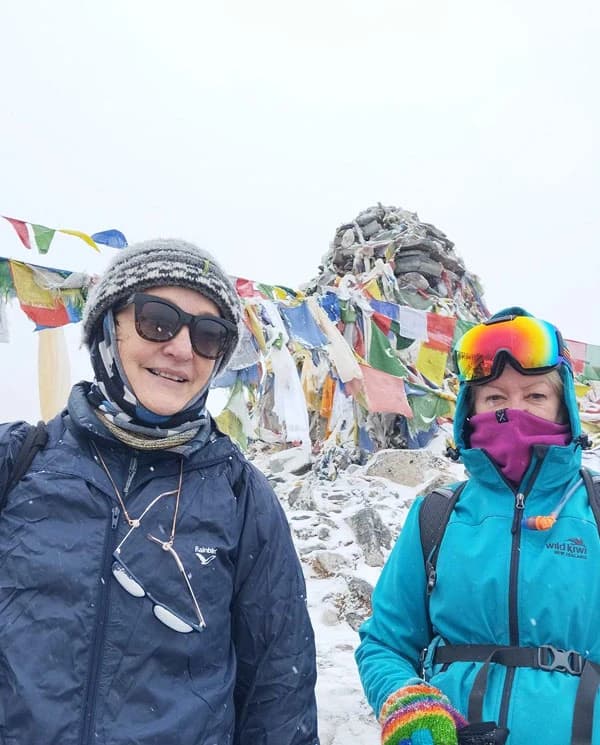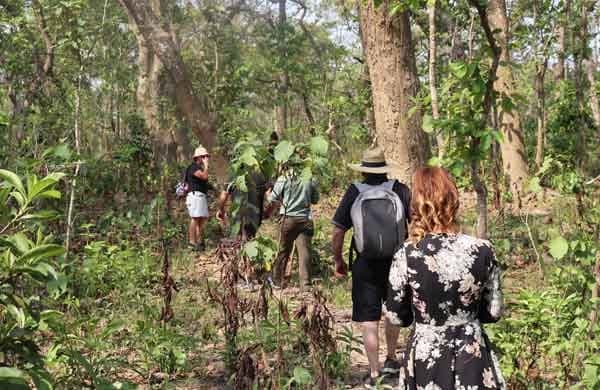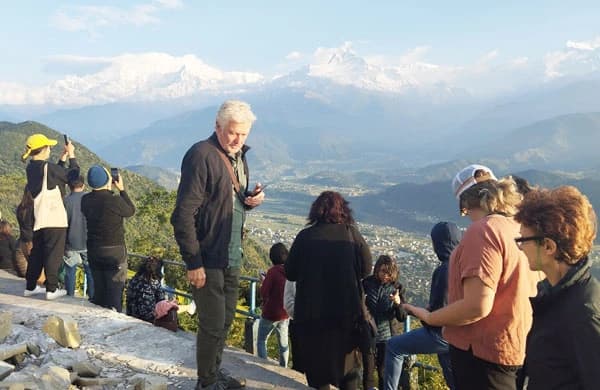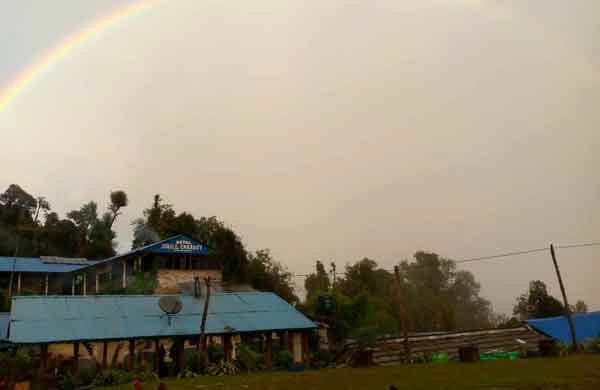Introduction to the Everest Cho La Pass Trek - 19 Days
The Cho La Pass Trek through EBC is perhaps the most spectacular, along with being a demanding trekking activity in Nepal. One of the most sought-after Himalayan treks, this trip combines two of the most popular Himalaya adventures, such as the Everest Base Camp (EBC) trek and traversing the Cho La Pass (5,420m).
During the journey, you will be intrigued by the beautiful, colorful turquoise Gokyo Lakes, stroll along the Ngozumpa Glacier (the longest glacier in Nepal), and be treated to breathtaking views of Mount Everest, Lhotse, Nuptse, AmaDablam, and Cho Oyu. These views are not just beautiful; they are inspiring, and they will leave a lasting impression on your soul. It is a unique experience of standing at the base of the highest mountain in the world, crossing Cho La Pass, and walking by the longest glacier in the Himalayas.
The 19 - day trip to Everest Cho La Pass is aimed at experienced trekkers who want to go beyond their limits. Through well-paced acclimatization, expert advice of guides, and precautionary measures, you will be traversing the high-altitude land with a touch of introspection to the Sherpa community and unforgettable landscapes in the Himalayan range.
During the 19-day Cho Pass with EBC Trek, explore the beautiful alpine Gokyo Lakes, cross a high mountain pass, Cho La, and pass by the biggest glacier in Nepal, Ngozumpa Glacier. Enjoy overnight stays in remote Sherpa villages and hike to EBC and Kala Patthar on the Cho La Pass trekking odyssey.
Everest Cho La Pass Trek requires good physical fitness and stamina. The Cho La Pass trail is also known as the Gokyo Lakes and Cho La Pass Trek with EBC. The magnificent mountain views, picturesque villages, intimate encounters with locals, and verdant forests make the Everest Cho La Pass Trek a lifetime venture. Everest Cho La Pass Trek allows you to spend more time in the mountains and enjoy many places of interest. We have meticulously planned the most beautiful overnight stays along the walking route, ensuring your comfort and a good night's sleep after walking. Rest assured, your safety and comfort are our top priorities.
19 - Days Cho La Pass With EBC Trek Highlights
- Exciting flight from Kathmandu to Lukla, which is one of the most thrilling airports in the world.
- Walk through lush forests of rhododendrons and beautiful, remote Sherpa villages
- Stand at Everest Base Camp (5,364m) and witness the mighty Khumbu Icefall.
- Trek through the Sagarmatha National Park, a UNESCO World Heritage site.
- Excellent side excursions to places like Everest View Hotel, Nagarjuna Hill, and Gokyo Ri during acclimatization days
- With the Ultimate Everest viewpoint, explore the gorgeous sunrise from Kala Patthar(5,545m).
- Reach Everest Base Camp
- Cross the Cho La pass and walk by the longest glacier in the Himalayas, Ngozumpa Glacier.
- Explore the Gokyo Lakes and the picturesque Gokyo village with a hike to Gokyo Ri for breathtaking panoramic views.
- Trek alongside glacial rivers, waterfalls, moraines, and high-altitude lakes.
- Guided cultural exploration of Kathmandu’s UNESCO heritage sites before you trek.
How Can You Reach the Cho La Pass?
Everest Chola Pass Trek begins with an exciting flight from Kathmandu to Lukla (2,846 m). Then, you'll traverse the Sagarmatha National Park, which starts from Monjo village (2,835 m) and goes up to Mt. Everest's top. On the same day as your flight to Lukla, you'll descend to Phakding village (2,610 m) to spend the night and acclimatize. In the next few days, you'll trek through different Sherpa villages, such as Namche Bazar (3,440 m), Tengboche (3,860 m), Dingboche (4,410 m), Lobuche (6,119 m), and Gorak Shep (5,164 m).
After exploring EBC (5,364 m) and Kala Patthar (5,644 m), you'll walk past Dzongla (4,830 m) and Thagnak (4,700 m). The trail then crosses the Cho La pass and passes alpine lakes to Gokyo village (4,750 m). The major ascending part ends at Gokyo Ri (5,357 m), a viewpoint that offers one of the best views of Everest and Cho Oyu. The next day, you'll explore the Gokyo Lakes (4,700 m-5,000 m) and descend to Machhermo (4,470 m).
The following two days involve walking to Namche Bazaar and retracing the trail back to Lukla. Our Cho La pass trek itinerary involves ample acclimatization days and, therefore, exciting side excursions to Hotel Everest View (3,962 m), Khumjung Monastery (3,790 m) in Namche Bazaar, and Nagarjuna Hill (5,100 m) in Dingboche. If you love glaciers, valleys, moraines, snow-capped mountains, lakes, mountain passes, bridges over rushing rivers, and the serenity of nature, then the EBC Cho La Pass Trek is for you.
Why you should do the Everest Cho La Pass Trek in 2026 and 2027
There are several reasons why you should consider the EBC Chola Pass Trek in the coming years, 2026 and 2027, and we have listed some of them below.
Guided sightseeing in Kathmandu
On the second day of the Everest Chola Pass trek Itinerary, we will arrange a full-day guided sightseeing tour of historical sites, led by one of our experienced tour guides.
The tour includes visits to UNESCO World Heritage Sites, such as the holy Pashupatinath Temple, one of the oldest temples in Nepal, and a pilgrimage site. The next monument is the largest Stupa in Nepal, the Boudhanath Stupa, and the famous Monkey Temple. Likewise, you'll explore Kathmandu Durbar Square. This monument was once a royal residence and is now an open museum featuring palaces, courtyards, and shrines.
Lifetime flight experience between Kathmandu and Lukla
You might have heard many things about Kathmandu-Lukla flights, such as how crazy the flight experience is, how overwhelming takeoff and landing are, and how frequent the delays are. Given the height of the Lukla airport (2,846 m) and the flying route, which includes towering mountains/peaks touching the clouds, you cannot expect anything else.
Similarly, the aerial views of the Himalayas will leave you in awe. The Kathmandu-Lukla flight provides a thrilling kick-start to your journey in the Himalayas.
Challenging Adventure
The Cho La Pass Trek is suitable for all types of people who want to experience adventure in their lifetime. Those who undertake treks cannot neglect the adventures that Cho La Pass presents, as it offers an array of adventurous activities and provides an opportunity to witness its stunning natural scenery. High-altitude trekking through glacial moraine, deep crevices, steep and rocky trails, and frozen lakes attracts more people.
Trek through lush forests, flora, and Fauna
The Cho La Pass, part of the EBC trek route, passes through juniper forests, as well as areas of magnolia, fir, and rhododendrons. It then climbs through dense alpine woodlands to Dingboche village. The trail is full of vegetation ranging from subtropical to alpine. Likewise, you'll encounter a variety of wildlife and birds. Above the tree line, you'll enjoy walking past bushes and pastures.
The Cho La pass is located in the conserved territory of the Sagarmatha National Park. It is very common to view and experience a diverse range of flora and Fauna in this zone. The landscapes of the Everest area feature diverse vegetation, which is a delight to the eye, and various animal species can also be observed here.
Sagarmatha National Park is home to several endangered species, including the snow leopard, musk deer, marten, Himalayan Tahr, Himalayan Mouse Hare, and the Red Panda. On the same note, there are about 118 species of birds here in this National Park.
Cultural Experience in beautiful, remote villages
Everest Cho La Pass Trek is also about experiencing the mountain lifestyle and culture of the local people. As the trail passes through beautiful Sherpa villages, you'll gain a firsthand understanding of their values. Interaction with locals and their warm hospitality will win your heart.
The Everest Region is very rich in natural and cultural terms. To enable trekkers to appreciate the beauty and significance of the culture, customs, and history, most residents in this region are Buddhists. Porters and guides will help trekkers to know about local customs and beliefs. You can also learn its performance, which has been practiced across the millennia in the Buddhist monasteries around the region.
You'll be able to participate in local customs and traditions, making your holiday genuinely immersive and culturally enriching.
Enjoy the wonders of the Khumbu region and Sagarmatha National Park.
Everest Cho La Pass trail is in the Sagarmatha National Park. You will come across streams, rivers, waterfalls, valleys, suspension bridges fastened with fluttering prayer flags, farming fields, glaciers, moraines, and lakes. The trail is very adventurous, as you can imagine.
Visit the Ancient Tengboche Monastery
One of the most significant points of the Cho La Pass Trek is a trip to the oldest and largest monastery in the region of Khumbu, Tengboche Monastery. This holy place carries heavy spiritual meaning, and it has long been a center of Tibetan Buddhism in the Everest region. Tengboche is a place that can host hundreds of monks and remains a welcoming house to trekkers, mountaineers, and worldwide pilgrims.
It is situated at 3,867 meters, which gives the monastery and its tourists an exquisite view of the Himalayas, and that includes its own iconic mountain, the Mt. AmaDablam, Everest, and Lhotse. The serene atmosphere and the recital of monks make it a really unforgettable escapade for anyone strolling around the Everest Cho La Pass Trails. There is even a legend that visiting pilgrims and tourists to this sacred place are blessed by Guru Rinpoche, and this gives an additional value in terms of spirituality to your journey.
Tengboche Monastery, built in 1916 by Lama Gulu, had to survive through numerous hardships. An earthquake wrecked it entirely in 1934, and it was restored the same year. In 1989, a second restoration occurred after a catastrophic fire. These tribulations notwithstanding, the monastery exists to this day as an epitome of indomitability and firmness- a position still in the largest and most significant religious venue of Khumbu.
Excellent side excursions during acclimatization days
During the Everest Cho La Pass Trek, we have a few acclimatization days. During these days, you'll explore the villages and observe locals doing their daily chores.
In the mornings, you will hike to nearby viewpoints, including Everest View Hotel, Nagarjuna Hill, and Gokyo Ri. These side excursions offer breathtaking views of the surrounding mountains and valleys, adding an extra layer of adventure and inspiration to your trekking holidays.
Stand at the base of the highest mountain in the world and explore the gorgeous sunrise from Kala Patthar. The trail leads to EBC, situated on the lap of Mt. Everest, the world's highest mountain. Reaching this point is usually the dream of hundreds and thousands of travellers worldwide. It's like standing at the top of the world in one way. Likewise, the Trek takes you to Kala Patthar, the famous viewpoint offering a panorama of snow-capped mountains. Again, sunrise is very renowned in Kala Patthar.
Cross the Cho La pass and walk by the biggest glacier in Nepal.
Cho La Pass is one of the three high passes in the Khumbu region. It stands 5,420 meters (17,782 ft) above sea level in the north-eastern part of Nepal, the Khumbu region. The pass connects Dzongla (4,830 m/15,850 ft) to the east and the village of Thagnak (4,700 m/15,400 ft) to the west.
Likewise, walking from Thangank to Gokyo Valley involves crossing the Ngozumpa glacier, Nepal's biggest glacier. Located below Mt. Cho Oyu, the sixth-highest mountain in the world, the 36-kilometer-long Ngozumpa Glacier is the longest in the Himalayas.
Explore Gokyo Lakes
The 6 Gokyo Lakes range from 4,700 to 5,000 m (15,400–16,400 ft). These are oligotrophic lakes, part of the world's highest freshwater lake system, comprising multiple lakes. DudhPokhari is the main lake in Gokyo village, and Thonak Cho is the largest lake. These lakes hold significant religious value for the locals of the region.
Witness stunning mountain views and diverse landscapes.
The landscapes change with every new village and only get captivating. Some of the mountains you get to see. At the same time, You will see Everest (8,848 m), Lhotse (8,516 m), AmaDablam (6,812 m), Nuptse (7,861 m), Thamserku (6,608 m), Pumori (7,161 m), Cho Oyu (8,188 m), Makalu (8,481 m), Kanchenjunga (8,586), Island Peak (6,160 m), and Chamlang (7,319 m).
Everest Cho La Pass Trek Altitude, Distance, and Walking hours
Cho La Pass Everest Trek is an extraordinary experience, doubling on the lap of nature and stamina. At Cho La Pass, it is possible that starting at 2,620 meters, you will peak at 5,420 meters (17,782 feet) altitude, where the air is thin and conditions are icy, and you will push your stamina to get through the pass.
The whole Cho La Pass trek consists of approximately 125/130km (8087 miles) in 14 walking days. You will spend an average of 6- 7 hours a day on the trail, with longer days, say 8 -9 hours, in high-altitude areas such as on the pass crossing. The path consists of vertical climbs, moraine, and descents on a glacier and rough downhill. Altitude sickness can indeed be avoided by proper days of acclimatization, which is incorporated in the itinerary. It is hard yet extremely worthwhile, and each hour upon the trail was full of Himalayan miracles, find the daily walking hours, altitude and distance, below.
EBC Cho La Pass Trek Altitude, Distance and Duration
| Itinerary |
Altitude (M) |
Distance (Km) |
Duration (H) |
| Lukla to Phakding |
2620 |
6 |
3-4 |
| Phakding to Namche Bazaar |
3440 |
8 |
7-8 |
| Namche Bazaar to Everest View |
3960 |
4 |
3-4 |
| Namche Bazaar to Tenghoche |
3860 |
9 |
5-6 |
| Tebgboche to Dingboche |
4410 |
12 |
6-7 |
| Dingbuche to Nagarjan Hill |
5100 |
4 |
3-4 |
| Dingboche Lobuche |
4910 |
8 |
6-7 |
| Lobuche to Gorekshep-EBC |
5364 |
15 |
7-8 |
| Gorekshep to Dzonglha |
5545 |
11 |
6-7 |
| Dzonglha to Thagnak |
5370 |
10 |
7-8 |
| Thagnak to Gokyo |
4790 |
4 |
3-4 |
| Gokyo - Gokyo Ri-Machhermo |
5365 |
11 |
7-8 |
| Machhermo to Namche Bazaar |
3440 |
10 |
6-7 |
| Namche Bazaar to Lukla |
2860 |
14 |
7-8 |
A Typical Day on Cho La Pass Trek
On the Cho La Pass Trek, a day begins with a delicious breakfast at your teahouse, which is normally served at 7:00 am. By 8 am, you resume trekking up a 4-5 hour trail through scenic forests, low starting suspension bridges, or river glacial moraines along the route, or the Yak pastures, depending on where you are being taken on a daily basis. At midday, you will have a hot meal in a teahouse in a small village, and then you will go further 2-3 hours ahead to the place of stay.
After arrival in your lodge, there is time to rest, enjoy a cup of tea, and soak up the mountain views, and you will take part in dinner. Subsequently, you have the option of taking a brief walk to visit the neighboring monasteries, spinning prayer wheels, or just relaxing in the calmness of the Sherpa villages with the star-studded skies, the beautiful Himalayan Mountains being their witness.
Nights are a cozy affair, with dinner served at 6:00 –7:00 pm, and this is accompanied by fun-filled chats with other trekkers by the fireside. Then it is time to go to bed early to charge up for another exciting day.
Is the Everest Cho La Pass Trek suitable for beginners?
Everest Cho La Pass Trek involves climbing, and the pass is rigorous; thus, it is not suitable for a complete beginner. Being at a high altitude, walking for a long time in the days, and a technical path along Cho La Pass requires some element of physical endurance and basic expertise in trekking.
Nonetheless, highly fit individuals with strong mental strength can do so in case of sufficient preparation and the accompaniment of an experienced guide on the journey. It is possible to gain confidence by first doing a couple of shorter treks such as Ghorepani Poon Hill or Langtang Valley. A Cho La Pass is quite difficult, and it is advised that most first-time trekkers should start with less challenging routes in the Everest region, such as the traditional Everest Base Camp Trek, before moving to Cho La Pass.
Solo Everest Cho La Pass Trek, Possible?
Have you always dreamed about conquering the Everest Cho La Pass Trek Solo? It is a High Himalaya journey of a lifetime, offering the epitome of freedom, self-discovery, and proving your mettle. Think of hiking at your own pace, enjoying the beautiful scenery in peace in the Himalaya, and inhaling Sherpa culture intimately at your own convenience. Solo Everest Chola Pass trekking enables one to connect more with locals and other travelers where one is in the journey and the pride experienced is empowering.
Nevertheless, this journey is not an easy one. Cho La Pass (5,420m) is a technically challenging and remote area where snow, ice, and sudden weather changes pose significant dangers. Therefore, having a local trekking guide does not compromise your independence. As a matter of fact, it can make your experience better by making sure that you are safe, assisting you in locating orientation and logistics arrangements.
Even when you are familiar and adept with going solo, trekking, and traveling to high altitudes, having a guide and a porter provides an additional element of protection and ease. They will assist in terms of navigation, logistics, and in case of emergency. A small group trip or the services of a personal guide is just the right compromise between thrill and safety for most travelers.
In case you have some trekking experience and are in need of some new adventures, the Everest Cho La Pass Trek may become your independent Himalayan dream, with a little professional assistance to keep it memorable and safe.
Everest Cho La Pass Trek with Family, Possible?
Everest Cho La Pass Trek with families is not an ordinary vacation, but it is a remarkable experience that allows you to deepen relations and establish unforgettable memories. Just think of how wonderful it will be when you are with your loved ones under the magnificent mountains of Everest, and feel the emotions of walking across high suspension bridges, through villages of Sherpa people, and being amazed by glaciers. It is an adventure that promotes collaboration, perseverance, and the fascination with the beauty of nature.
The EBC Chola Trek is demanding, with long walking days, steep climbs, and a high-altitude pass at 5,420 meters. This excursion will be ideal for those families with children, if you have rather big children (15+ years old) or teenagers; they should be active people and love the adventure. Even this difficult path can be transformed into an exciting family experience with appropriate acclimatization, gradual pace, and encouragement from seasoned guides and porters. You can organize your own itinerary and make it with more days off and fewer trekking hours, according to how comfortable your group feels.
It is not rubbing shoulders with Cho La pass in the Himalayas, but traveling with your family and sharing sunrises over Mount Everest, cuddling in mountain teahouses, and experimenting with challenges together. This trek is meant to leave adventurous families with lifetime stories. Family Chola Pass Trekking gives a rare chance to enjoy bonding time together while exploring the culture of the Sherpas, trekking along with Everest, and overcoming challenges. It is advisable to get the services of experienced guides and porters, as it makes the journey smoother.
Why Book Everest Cho La Pass with Outfitter Himalaya
Reserving your Everest Cho La Pass Trek through Outfitter Himalaya brings you a team that has a good idea about all the twists and turns of the Khumbu region. At Outfitter Himalaya, we are certain that the adventure you experience in the Himalayas should be as smooth and hassle-free as possible.
You know we are not guides only, but your partners in adventure. Whether it is in permitting and lodging to your general safety on difficult parts such as Cho La Pass, our skilled personnel will ensure your comfort. This is why we have arranged a complete package of the Cho La Pass with EBC Trek, and it includes airport transfers and hotels, city tours, domestic flights, and knowledgeable guides and porters.
We are glad to offer pocket-friendly packages without denting quality. We also have a simple booking procedure that only needs a 20% deposit to secure your trek, with the rest to be paid when you get to the country. Not only that, you will also be able to use trekking equipment such as sleeping bags and down jackets, duffle bags at no cost, which saves you money and luggage loads.
There are adequate acclimatization days and pacing on our itineraries so that you can enjoy the experience and not be in a rush to be there. After years of experience in trek arrangements in Nepal, we have competitive prices that do not compromise the quality of the service. In addition, we make sure that small group sizes permit a customized experience.
Consider travelling without fear because we will take care of your safety and comfort. We assure you that we do not cancel trips because of small numbers of bookings, as many operators do. In case you are the sole trekker, your trip is not canceled. We want our groups to be intimate (maximum 12 people) so that we can give them a more personal touch. And with 24/7 support through phone or WhatsApp (+9779851137380), you do not go alone in the planning or on the trail.


















